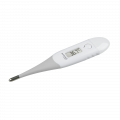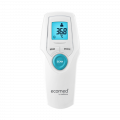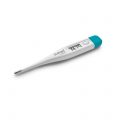Fever Thermometer – A Must-Have for Every Household
Fever is often an early warning sign and the first indication that your body is fighting something. With a fever thermometer, you can monitor symptoms and make decisions that truly matter. Whether it’s sudden shivering, a runny nose, or just an uneasy feeling, a quick check provides clarity.
From classic digital to contactless infrared models, modern fever thermometers make temperature checks easier and more accurate than ever for you and your family. No more guesswork — just precise results that tell you exactly what’s happening when it matters most.
From Traditional to Digital – How Modern Fever Thermometers Work
A fever thermometer is a smart everyday tool that tells you within seconds what your body needs — whether for a quick check or just for peace of mind. Modern thermometers provide precise results in no time when fever occurs, thanks to technology that has evolved significantly in recent years.
• Digital Fever Thermometers: These popular and reliable classics use electronic sensors to measure your temperature with precision. An acoustic signal lets you know when the measurement is complete — no more second-guessing. You can use them orally (in the mouth), axillary (under the armpit), or rectally. Did you know that rectal measurement is considered as the most accurate method?
• Infrared Fever Thermometers: The leading contactless solution, often referred to as laser thermometers. With a quick scan of the forehead, you receive a result in seconds – no contact, fully hygienic. Ideal for children or when every second counts. Some models are also designed for in-ear measurement that provide highly accurate results.
Do you remember the old-fashioned glass thermometers that had to be vigorously shaken down after each use? These older models contained mercury – a substance now considered hazardous to health.
Modern fever thermometers prioritise safety and comfort: they are shatterproof, free from harmful substances, and provide precise readings without the risk of misinterpretation. With features like illuminated displays and built-in memory functions, temperature measurement becomes stress-free — even in the middle of the night or amid the chaos of family life.
Fever Measurement Made Simple– Digital and Infrared Thermometers in Everyday Life
Whether it’s a quick check in the ear, a hygienic measurement on the forehead, or the classic method under the tongue, modern digital and infrared thermometers make fever measurement precise, easy, and, above all, versatile. But what are the differences between these health devices, and how do you use them correctly?
Digital Fever Thermometer – Precise All-Rounders
Digital thermometers are true multitaskers, allowing temperature measurement at various body sites:
• Oral: Provides precise results, making it ideal for older children and adults.
• Axillary: Placed easily under the armpit, optimal for quick and hassle-free checks.
• Rectal: The most reliable method for babies and toddlers, with flexible tips ensuring a comfortable and safe experience.
The results appear on a clear, and easy-to-read display, accompanied by a signal tone that indicates when the measurement is complete. An essential everyday item.
Infrared Thermometer – More Than Just Fever Measurement
For contactless and hygienic temperature measurement, infrared thermometers are the top choice. Depending on the model, they scan the forehead or measure temperature directly in the ear, delivering results in no time. But there’s more:
• Versatile use: Infrared thermometers measure not only body temperature but also ambient temperature, as well as the temperature of liquids and surfaces.
• Practical features: Up to 30 readings can be stored, allowing you to track temperature changes over time. This is a real advantage, especially in stressful situations.
No matter whether you use a digital or infrared thermometer, you should check the temperature at least twice a day—and more frequently if the fever is high. But don’t panic: as long as you generally feel well, a little patience and rest are usually the best approach. Listen to your body — it often gives you the best signals.
The Numbers on a Fever Thermometer – What Your Body Is Telling You
Fever isn’t an enemy — it’s your body’s smart defence mechanism. When pathogens enter, your immune system responds by raising your body temperature, making it harder for viruses and bacteria to thrive.
But when is it actually considered a fever? And when should you be concerned? A fever thermometer helps you measure your temperature accurately — and that’s important, as even small fluctuations can provide valuable insights into your health.
| Temperature Range | Category | Explanation |
|---|---|---|
| Below 35.5 °C | Low Body Temperature | May indicate exhaustion or circulatory issues. |
| 36.5–37.5 °C | Normal Body Temperature | Within the healthy range – your body is functioning optimally. |
| 37.6–38.0 °C | Elevated Temperature | Your body is responding – an early warning sign. |
| 38.1–39.0 °C | Mild to Moderate Fever | Your immune system is active. Rest and hydration can help. |
| 39.1–40.0 °C | High Fever | Time to reduce the fever or seek medical advice, especially if it persists. |
| Above 40.0 °C | High Fever | Danger! Immediate medical attention is required. |
These values provide a rough overview, but your overall condition and individual health factors should always be taken into account. And when in doubt, always consult a doctor.
Did you know that children naturally have a slightly higher body temperature than adults? Their normal temperature range is 36.5°C to 38.0°C, which is completely harmless. However, be aware that in children, a fever is considered to begin at 38.5°C, while in infants under three months, a temperature of 38.0°C is already classified as a fever.
It’s always worth having a reliable fever thermometer within reach so that you can act quickly when needed. After all, the more clearly you understand the situation, the calmer you — and your whole family — will be.


